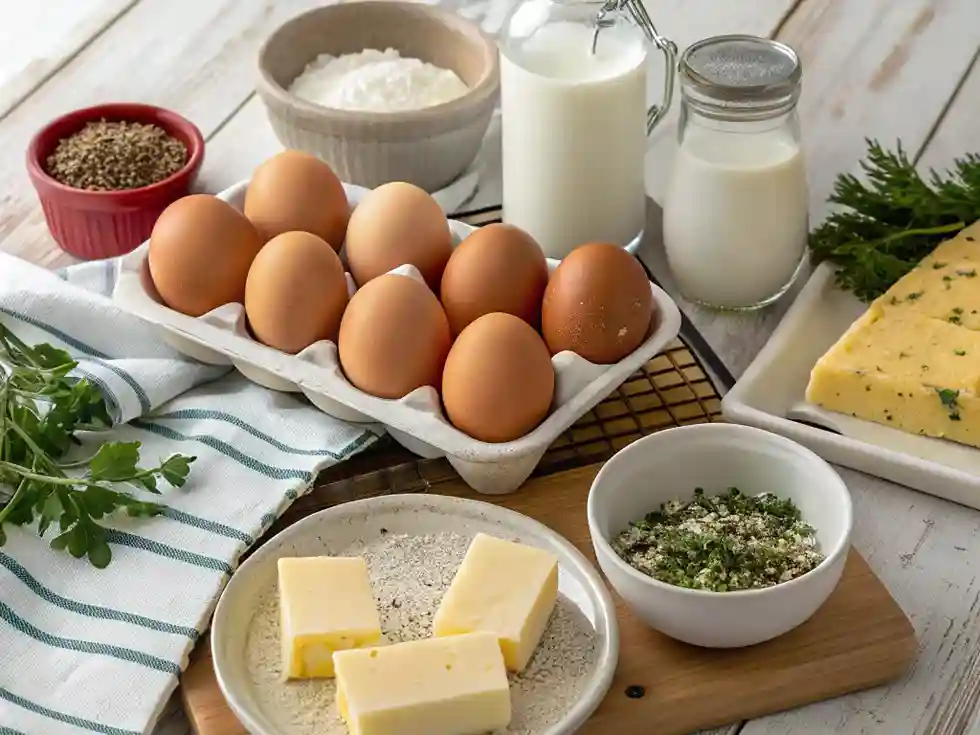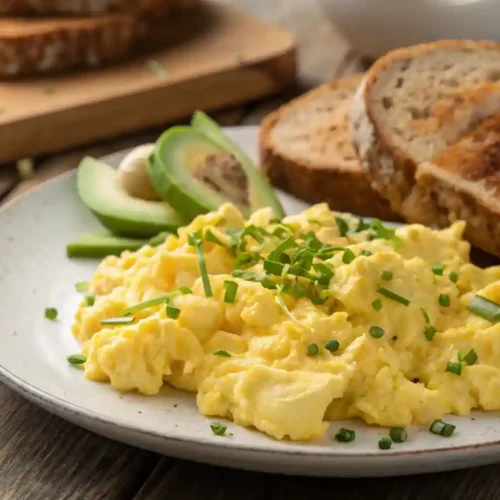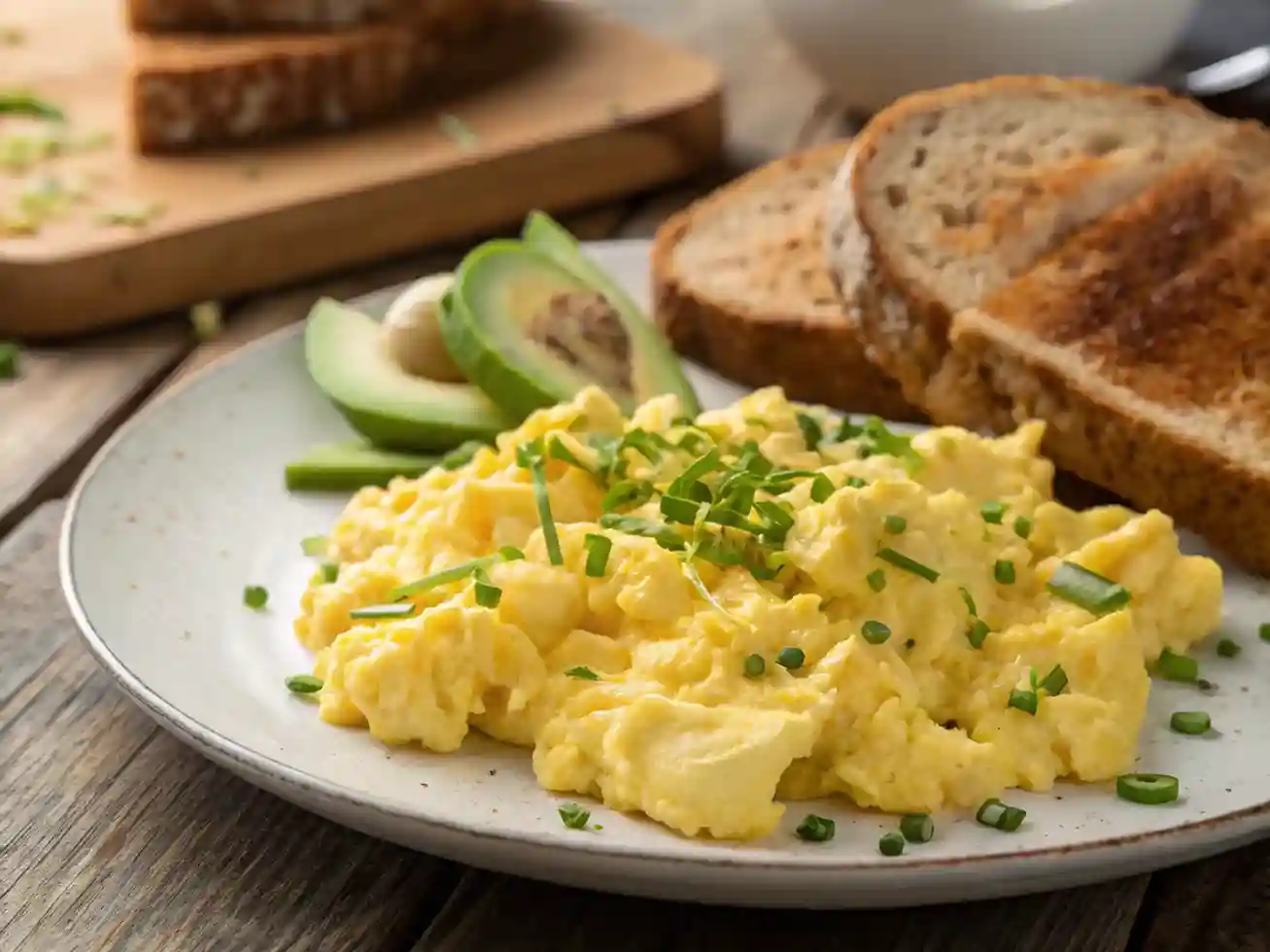Who doesn’t love a plate of warm, fluffy scrambled eggs? They’re a breakfast staple, packed with high-quality protein, essential vitamins, and healthy fats—but are they as nutritious as they are delicious? Whether you’re looking to fuel your morning, support muscle growth, or enjoy a low-carb, high-protein meal, scrambled eggs can be a powerhouse of nutrition.
But here’s the catch—your choice of ingredients and cooking method can make all the difference. Are you using butter or olive oil? Adding milk or keeping it simple? Small tweaks can enhance the health benefits while keeping that creamy, satisfying texture.
Table of Contents
Essentials Ingredients you need for Scrambled Eggs Nutrition Facts

Crafting the perfect scrambled eggs starts with selecting high-quality ingredients. The simplicity of this dish means that every element plays a crucial role in flavor, texture, and nutritional value. Here’s what you’ll need to create creamy, fluffy, and nutrient-rich scrambled eggs.
Essential Ingredients
- Eggs (2-4 large, organic or pasture-raised preferred) – A powerhouse of protein, healthy fats, and essential vitamins. Fresh eggs yield the best texture and taste.
- Butter (1 tablespoon, unsalted, grass-fed if available) – Adds richness, enhances flavor, and prevents sticking while cooking.
- Milk or cream (1-2 tablespoons, optional) – Helps achieve a softer, fluffier consistency. you can use milk or heavy cream its works beter.
- Salt (to taste, preferably sea salt or Himalayan salt) – Enhances the natural flavors of the eggs.
- Black pepper (to taste, freshly ground preferred) – Adds a subtle kick and depth to the dish.
Optional Additions for Extra Flavor and Nutrition
- Cheese (cheddar, feta, parmesan, or goat cheese, finely grated or crumbled) – Increases protein content and adds a creamy, savory touch.
- Herbs (chives, parsley, basil, or thyme, finely chopped) – Fresh herbs elevate the flavor profile while adding antioxidants.
- Vegetables (spinach, mushrooms, tomatoes, or bell peppers, diced and pre-cooked if necessary) – Boosts vitamins, fiber, and overall nutritional value.
- Protein Boosters (smoked salmon, turkey, or crispy bacon, chopped) – A great way to increase protein intake while enhancing taste.
- Spices (paprika, cayenne pepper, or garlic powder) – Adds warmth and depth to the flavor without overpowering the eggs.
How to Make Perfect Scrambled Eggs Step by Step

Mastering scrambled eggs is all about technique. The key to achieving soft, creamy, and fluffy eggs lies in low heat, constant stirring, and the right balance of fat and seasoning. Follow these step-by-step instructions for the best scrambled eggs every time.
Step 1: Prepare the Ingredients
Before starting, gather all the ingredients. Crack the eggs into a bowl, add just small pinch of salt and pepper if you like, and whisk until fully combined. If using milk or cream, mix it in at this stage for extra creaminess.
Step 2: Heat the Pan and Melt the Butter
Use a non-stick or cast-iron skillet for even cooking. Set the heat to low or medium-low and add butter, allowing it to melt gently without browning. A low temperature is crucial for preventing overcooked, rubbery eggs.
Step 3: Cook the Eggs Slowly
- Pour the beaten eggs into the pan.
- Let them sit undisturbed for about 10-15 seconds until the edges start to set.
- Using a rubber spatula, gently stir the eggs in slow, circular motions, pushing the cooked parts toward the center.
- Continue stirring and folding the eggs as they cook, ensuring they stay soft and creamy.
Step 4: Remove from Heat at the Right Time
As soon as the eggs are just slightly undercooked, remove the pan from heat. The residual warmth will continue to cook them. Overcooking leads to dry, rubbery eggs, so timing is key.
Step 5: Add Finishing Touches
For an extra burst of flavor and nutrition, stir in grated cheese, fresh herbs, or sautéed vegetables. If you’re exploring egg alternatives, you might enjoy this Vegan Cheese Omelette, which offers a delicious, plant-based twist with high-protein ingredients.
Step 6: Serve Immediately
Transfer the scrambled eggs to a warm plate and enjoy them while they’re soft and silky. Pair with whole-grain toast, avocado slices, or smoked salmon for a complete, nutrient-rich meal.
By following these steps, you’ll consistently create perfect scrambled eggs with the ideal balance of flavor, texture, and nutrition.
Serving Suggestions
Scrambled eggs are incredibly versatile and pair well with a variety of side dishes to create a satisfying and nutritious meal. Whether you’re enjoying them for breakfast, brunch, or a light dinner, here are some delicious ways to serve scrambled eggs while maximizing their flavor and nutritional benefits.
1. Classic Breakfast Plate
For a balanced and energy-boosting breakfast, pair scrambled eggs with:
- Whole-grain toast or sourdough – Adds fiber and complements the creamy texture of the eggs.
- Avocado slices – Provides heart-healthy fats and a creamy contrast to fluffy eggs.
- Turkey bacon or smoked salmon – A high-protein option that enhances the dish’s savory profile.
2. Protein-Packed Power Bowl
For those looking to increase their protein intake, scrambled eggs can be served in a hearty power bowl:
- Quinoa or brown rice as a fiber-rich base.
- Sautéed spinach, mushrooms, or bell peppers for added vitamins and minerals.
- A sprinkle of feta or shredded cheddar cheese for extra creaminess and protein.
3. Low-Carb and Keto-Friendly Options
Scrambled eggs are naturally low in carbohydrates, making them perfect for a keto or low-carb meal:
- Serve with sautéed zucchini noodles or roasted asparagus for a nutrient-dense side.
- Pair with crispy bacon or grilled sausage for added protein.
- Top with a dollop of sour cream and chopped chives for extra flavor.
Why Scrambled Eggs Are a Nutritional Powerhouse
Scrambled eggs are more than just a quick and easy breakfast option. They are a nutrient-dense, high-protein food that offers a perfect balance of healthy fats, essential vitamins, and quality protein to keep you feeling full and energized throughout the day.
The Health Benefits of Scrambled Eggs
- Rich in Protein – Each serving provides a complete protein source with all nine essential amino acids, supporting muscle growth and repair.
- Packed with Vitamins and Minerals – Scrambled eggs are a natural source of B vitamins, including B12, which is crucial for brain function and energy production.
- Supports Heart Health – When consumed in moderation, eggs contain heart-friendly nutrients like choline and omega-3 fatty acids, which help maintain cardiovascular health.
- Great for Weight Management – High in protein and healthy fats, scrambled eggs promote satiety, helping to curb cravings and support weight loss.
- Boosts Brain Function – With a rich supply of choline and antioxidants, eggs contribute to improved cognitive function and overall mental clarity.
Customizing Scrambled Eggs to Fit Your Diet
One of the best things about scrambled eggs is their versatility. Whether you’re following a keto, high-protein, low-carb, or vegetarian diet, you can easily modify scrambled eggs to align with your nutritional needs. Adding cheese, fresh vegetables, lean proteins, or healthy fats can enhance both flavor and nutritional value.
For those who prefer plant-based alternatives, exploring dishes like Anjappar Egg Fried Rice can introduce new ways to enjoy egg-based meals with a creative twist.
FAQs: Scrambled Eggs and Nutrition
1. Is scrambled egg healthier than fried?
Yes, scrambled eggs are generally considered healthier than fried eggs, especially when cooked with minimal butter or oil. Fried eggs often require more fat, which increases the overall calorie count. However, both methods retain the essential nutrients found in eggs, such as protein, healthy fats, and vitamins. If you’re aiming for a healthier version, opt for scrambled eggs cooked on low heat with a small amount of olive oil or grass-fed butter.
2.Why eat raw eggs instead of cooked?
Some people consume raw eggs for their high protein content and bioavailability of certain nutrients. However, cooking eggs enhances their protein digestibility, making them easier for the body to absorb. Cooking also eliminates the risk of Salmonella and other bacteria found in raw eggs. If you prefer raw eggs, choose pasteurized eggs to minimize health risks.
3. Is scrambled eggs good for a diet?
Yes, scrambled eggs can be an excellent choice for weight loss and muscle-building diets. They are high in protein, low in carbs, and packed with essential nutrients. However, the way you prepare them matters. Avoid excessive butter, cheese, or heavy cream to keep the calorie count in check. Pair scrambled eggs with vegetables or lean proteins for a balanced, low-calorie meal.
4. Why are scrambled eggs so high in calories?
The caloric content of scrambled eggs depends on how they are prepared. While eggs themselves are not high in calories, adding butter, milk, cheese, or oil significantly increases the calorie count. To make a lower-calorie version, cook scrambled eggs with a small amount of olive oil and skip the heavy dairy products.

Scrambled Eggs Nutrition Facts The Truth Will Surprise You
Ingredients
Eggs (2-4 large, organic or pasture-raised preferred)
- – A powerhouse of protein healthy fats, and essential vitamins. Fresh eggs yield the best texture and taste.
Butter (1 tablespoon, unsalted, grass-fed if available)
- – Adds richness enhances flavor, and prevents sticking while cooking.
Milk or cream (1-2 tablespoons, optional)
- – Helps achieve a softer fluffier consistency. Whole milk or heavy cream works best.
Salt (to taste, preferably sea salt or Himalayan salt)
- – Enhances the natural flavors of the eggs.
Black pepper (to taste, freshly ground preferred)
- – Adds a subtle kick and depth to the dish.
Optional Additions for Extra Flavor and Nutrition
Cheese (cheddar, feta, parmesan, or goat cheese, finely grated or crumbled)
- – Increases protein content and adds a creamy savory touch.
Herbs (chives, parsley, basil, or thyme, finely chopped)
- – Fresh herbs elevate the flavor profile while adding antioxidants.
Vegetables (spinach, mushrooms, tomatoes, or bell peppers, diced and pre-cooked if necessary)
- – Boosts vitamins fiber, and overall nutritional value.
Protein Boosters (smoked salmon, turkey, or crispy bacon, chopped)
- – A great way to increase protein intake while enhancing taste.
Spices (paprika, cayenne pepper, or garlic powder)
- – Adds warmth and depth to the flavor without overpowering the eggs.
Instructions
Step 1: Prepare the Ingredients
- Before starting, gather all the ingredients. Crack the eggs into a bowl, add a pinch of salt and pepper, and whisk until fully combined. If using milk or cream, mix it in at this stage for extra creaminess.
Step 2: Heat the Pan and Melt the Butter
- Use a non-stick or cast-iron skillet for even cooking. Set the heat to low or medium-low and add butter, allowing it to melt gently without browning. A low temperature is crucial for preventing overcooked, rubbery eggs.
Step 3: Cook the Eggs Slowly
- Pour the beaten eggs into the pan.
- Let them sit undisturbed for about 10-15 seconds until the edges start to set.
- Using a rubber spatula, gently stir the eggs in slow, circular motions, pushing the cooked parts toward the center.
- Continue stirring and folding the eggs as they cook, ensuring they stay soft and creamy.
Step 4: Remove from Heat at the Right Time
- As soon as the eggs are just slightly undercooked, remove the pan from heat. The residual warmth will continue to cook them. Overcooking leads to dry, rubbery eggs, so timing is key.
Step 5: Add Finishing Touches
- For an extra burst of flavor and nutrition, stir in grated cheese, fresh herbs, or sautéed vegetables. If you’re exploring egg alternatives, you might enjoy this Vegan Cheese Omelette, which offers a delicious, plant-based twist with high-protein ingredients.
Step 6: Serve Immediately
- Transfer the scrambled eggs to a warm plate and enjoy them while they’re soft and silky. Pair with whole-grain toast, avocado slices, or smoked salmon for a complete, nutrient-rich meal.
Notes
Nutrition Information (Per Serving)
- Calories: 200
- Protein: 14g
- Fat: 15g
- Carbohydrates: 2g
- Saturated Fat: 6g
- Cholesterol: 370mg
- Sodium: 210mg
- Fiber: 0g
- Sugar: 1g
Recipe Category
- Course: Breakfast, Brunch
- Cuisine: American, Global
- Diet: High-Protein, Low-Carb, Keto-Friendly
- Method: Stovetop Cooking
- Keyword: Scrambled eggs, Fluffy eggs, Healthy breakfast, High-protein eggs
- Skill Level: Beginner-Friendly











